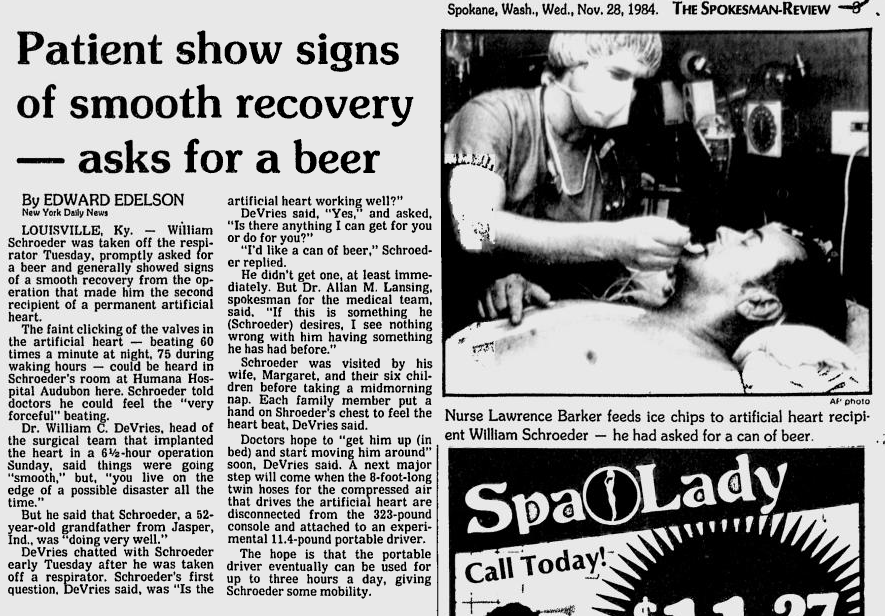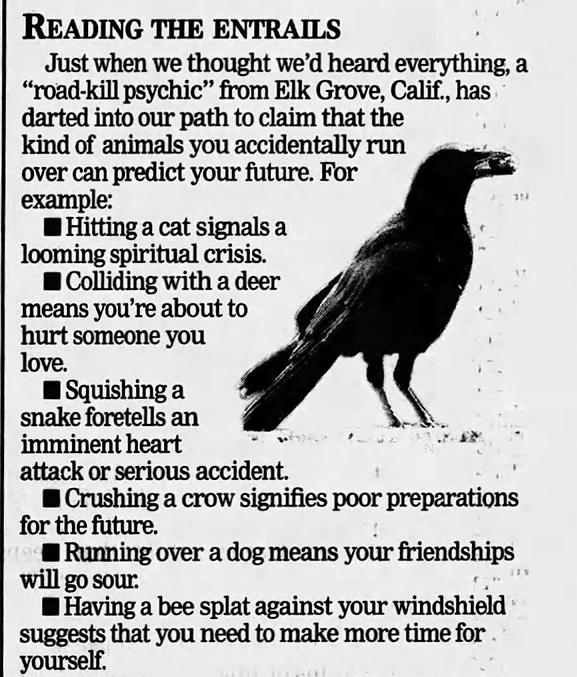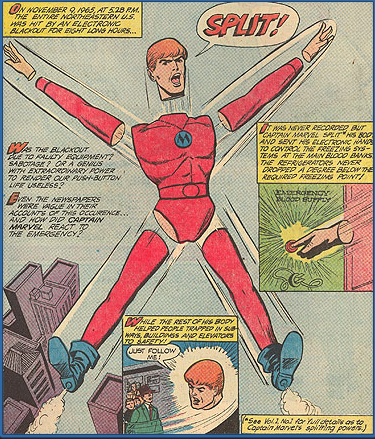Death
The Leaping Lawyer of Toronto
Lawyer Garry Hoy worked on the 24th floor of the Toronto-Dominion Bank Tower. Hi’s favorite trick, during office parties, was to demonstrate how the building's glass windows were unbreakable. He did this by hurling himself at them. But when he performed his trick in July 1993, the window unexpectedly broke, sending him plummeting to his death.Based on notoriety alone, I’d say this has to qualify as one of the top 25 weird news stories of all time. Wikipedia notes that it’s been featured on a number of television shows (such as Mythbusters), and was also re-enacted in the 2006 movie The Darwin Awards.
More info: wikipedia, snopes

The Ottawa Citizen - July 12, 1993

National Post - July 13, 1993
Posted By: Alex - Fri Jul 26, 2019 -
Comments (5)
Category: Death, 1990s
The Cremain Comic Book
We've posted before about how, when Frisbee-inventor Ed Headrick died in 2002, his ashes were incorporated into special-edition frisbees that were sold for $200.Along similar lines, when comic book writer Mark Gruenwald died in 1996, some of his cremains were mixed into the printer's ink for the trade paperback compilation of his Squadron Supreme graphic novel. As explained by his widow:
If you're interested, You can buy a copy of the cremain edition on eBay for $199.99.
I wonder how many other mass-produced items have contained someone's cremains?

Posted By: Alex - Sun Jul 21, 2019 -
Comments (1)
Category: Death, Comics, 1990s
“Breakfast” by Cyriak
Posted By: Paul - Fri Jul 19, 2019 -
Comments (3)
Category: Annoying Things, Daredevils, Stuntpeople and Thrillseekers, Death, Destruction, Food, Highways, Roads, Streets and Traffic, Surrealism, Foreign Customs, Fictional Monsters, Cars
Death Awareness Cafe
It's a coffee shop that encourages you to contemplate the Grim Reaper while sipping your cup of Joe. Seems like a perfect place to serve those Decomposition Cupcakes we posted about a few months ago.More info: upi.com
(You can find a transcript of what the guy in the video is saying here.)
Posted By: Alex - Wed Jul 10, 2019 -
Comments (2)
Category: Business, Death, Coffee and other Legal Stimulants
Signs of Health

Alas, this positive sign was not an accurate forecast of the fate of William Schroeder.
Article source.
Posted By: Paul - Wed Jul 10, 2019 -
Comments (2)
Category: Body, Death, Health, Surgery, 1980s, Alcohol
Roadkill Psychic
In the late 1990s, psychic Terrie Brill of Elk Grove, California made headlines by claiming that roadkill could be used to predict the future. Specifically:Running over a deer means you're about to hurt someone you love.
Crushing a crow with your car means you're not prepared for the future.
Rolling over a snake could mean you're about to have a heart attack or other serious accident.
If you run over a dog, expect your friendships to take a turn for the worse.
If a bee collides with your windshield, you need to make more time for yourself.
... mashed mosquitos have no effect whatsoever on your future.
Brill died in 2001, but her son maintains a Facebook page about her, promoting her posthumously published book The I-Factor. Unfortunately, the Facebook page doesn't seem to contain anything about the roadkill predictions.

Terrie Brill

Edmonton Journal - Sep 8, 1998
Posted By: Alex - Sun Jun 16, 2019 -
Comments (1)
Category: Animals, Death, Predictions, 1990s
The Death Test
It's officially known by the acronym CrisTAL (Criteria for Screening and Triaging to Appropriate Alternative Care), but it's more widely known as the Death Test. It's a 29-point checklist to help doctors determine if elderly patients are at risk of dying within the next three months. So, it seems like a more rigorous version of the "Surprise Question" which (as we've posted about before) is another test docs use to predict imminent death.More info: funeralwise.com
The Death Test:
1. Altered level of consciousness (Glasgow Coma Score change >2 or AVPU=P or U)
2. Blood pressure (a systolic blood pressure of less than 90 mm Hg)
3. Respiratory rate of more then five and less than 30
4. Pulse rate of less than 40 or more than 140
5. Need for oxygen therapy, or known oxygen saturation of less than 90 per cent
6. Hypolglaecemia blood glucose level (less sugar in the blood than normal)
7. Repeat or prolonged seizures
8. Low output of urine (less than 15 mL/h or less than 0.5 mL/kg/h) or a MEW or SEWS score of more than 4
9. Previous history of disease, including:
10. Advanced cancer
11. Kidney disease
12. Heart failure
13. Various types of lung diseases
14. Strokes and vascular dementia
15. Heart attack
16. Moderate to severe liver disease
17. Mental impairment such as dementia or disability from a stroke
18. Length of stay before this RRT call (>5 days predicts 1-year mortality)
19. Repeat hospitalisations in the past year
20. Repeat admission to the intensive care department of the hospital
21. Frailty
22. Unexplained weight loss
23. Self-reported exhaustion
24. Weakness (being unable to grip objects, being unable to handle objects or lift heavy objects of less than or equal to 4.5kg,
25. Slow walking speed (walks 4.5m in more than 7 seconds) or is
26. Inability to do physical exercise or stand
27. Is a nursing home resident or lives in supported accommodation
28. Having urine in their blood (more than 30mg albumin/g creatinine
29. Abnormal ECG (irregular heartbeat, fast heartbeat and any other abnormal rhythm or more than or equal to 5 ectopics/min and changes to Q or ST waves)
Posted By: Alex - Thu Jun 13, 2019 -
Comments (2)
Category: Death, Medicine
The House in the Middle
Atomic bombs hate slums, but respect a nice clean domicile.
Posted By: Paul - Thu Jun 13, 2019 -
Comments (4)
Category: Buildings and Other Structures, Death, Destruction, Domestic, War, 1950s
Flying Body Parts Lawsuit

Ruling in what it called a "tragically bizarre" case, an appeals court found that the estate of a man killed by a train while crossing the Edgebrook Metra station tracks can be held liable after a part of his body sent airborne by the collision struck and injured a bystander.
In 2008, Hiroyuki Joho, 18, was hurrying in pouring rain with an umbrella over his head, trying to catch an inbound Metra train due to arrive in about five minutes when he was struck by a southbound Amtrak train traveling more than 70 mph.
A large portion of his body was thrown about 100 feet on to the southbound platform, where it struck Gayane Zokhrabov, then 58, who was waiting to catch the 8:17 a.m. train to work. She was knocked to the ground, her leg and wrist broken and her shoulder injured.
More details at the source.
Posted By: Paul - Mon May 20, 2019 -
Comments (1)
Category: Accidents, Body, Death, Lawsuits, Trains and Other Vehicles on Rails, Twenty-first Century
Decapitation Experiment
Weird science: How long does a severed head remain conscious? In 1905, Dr Gabriel Beaurieux used the opportunity of the execution of the criminal Henri Languille by guillotine to attempt to find out. From a contemporary newspaper account of the scene:"Languille! Languille!"
Terrible stillness for a moment. And, look! The dead head actually obeys! The eyelids open, and two eyes, abundant with life, glare questioning at Dr. Beaurieux—and then the lids close.
But the doctor has no mercy—he is experimenting. And once more he commands:
"Languille!"
Again the eyelids open, and two soulless eyes attempt to see, to find a point in the space. A conscious struggle really is proceeding, until the lids again close. But for the third time Dr. Beaurieux raises the head up in the air:
"Languille!"
This time in vain. The experiment had lasted thirty seconds, and now the question is:
Has the reflecting movement released other functions of the brain? Did Languille know that they called him, and that he had better awaken and answer? Gruesome it were, if he really had answered, for instance repeated his "Goodbye, you beautiful life!"

The execution of Henri Languille - source: wikipedia

The Racine Journal Times - Aug 23, 1905
Posted By: Alex - Thu May 16, 2019 -
Comments (5)
Category: Death, Science, Experiments, 1900s

| Who We Are |
|---|
| Alex Boese Alex is the creator and curator of the Museum of Hoaxes. He's also the author of various weird, non-fiction, science-themed books such as Elephants on Acid and Psychedelic Apes. Paul Di Filippo Paul has been paid to put weird ideas into fictional form for over thirty years, in his career as a noted science fiction writer. He has recently begun blogging on many curious topics with three fellow writers at The Inferior 4+1. Contact Us |




